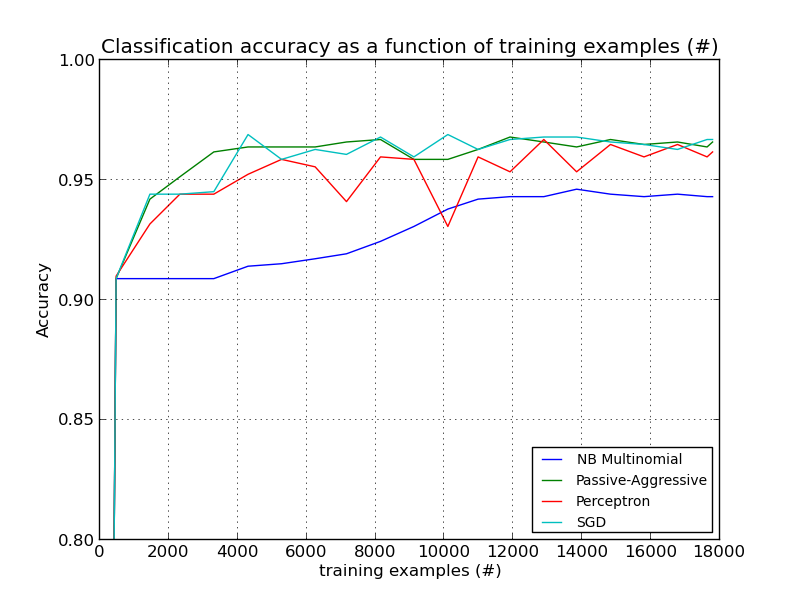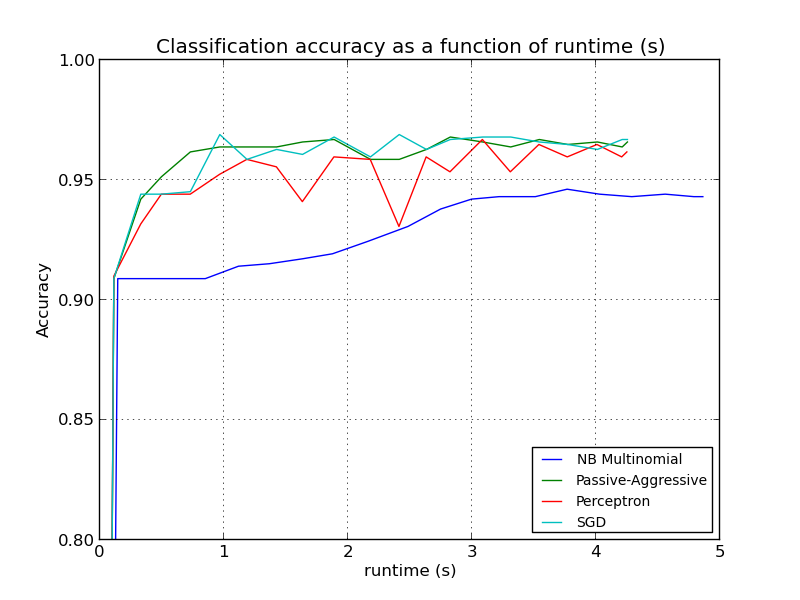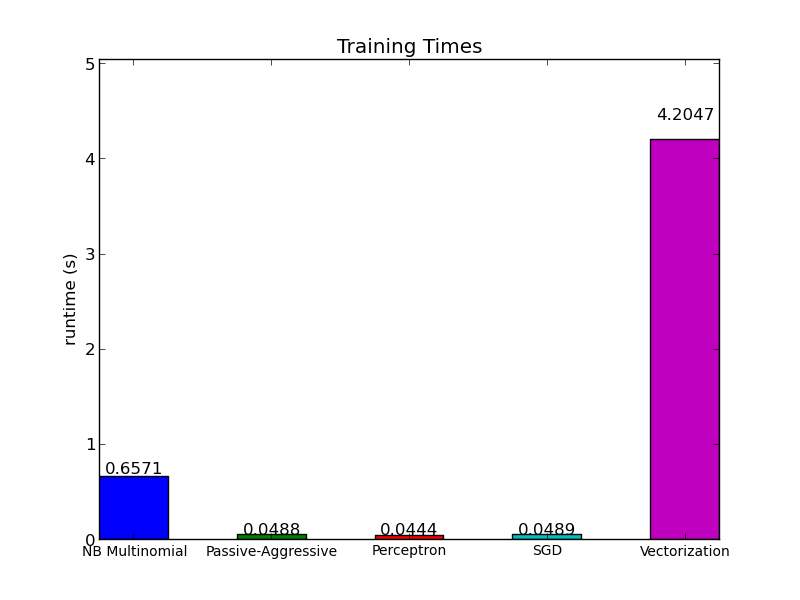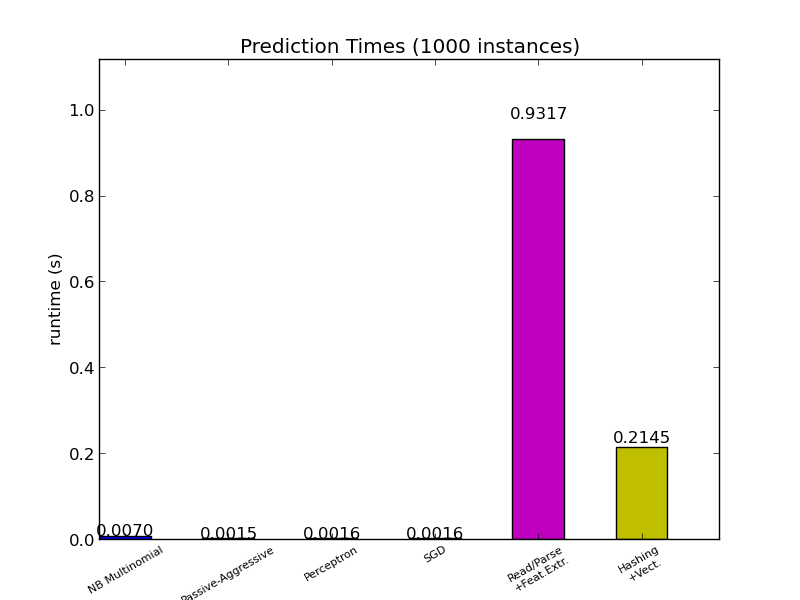Out-of-core classification of text documents¶
This is an example showing how scikit-learn can be used for classification using an out-of-core approach: learning from data that doesn’t fit into main memory. We make use of an online classifier, i.e., one that supports the partial_fit method, that will be fed with batches of examples. To guarantee that the features space remains the same over time we leverage a HashingVectorizer that will project each example into the same feature space. This is especially useful in the case of text classification where new features (words) may appear in each batch.
The dataset used in this example is Reuters-21578 as provided by the UCI ML repository. It will be automatically downloaded and uncompressed on first run.
The plot represents the learning curve of the classifier: the evolution of classification accuracy over the course of the mini-batches. Accuracy is measured on the first 1000 samples, held out as a validation set.
To limit the memory consumption, we queue examples up to a fixed amount before feeding them to the learner.
Script output:
Test set is 966 documents (88 positive)
Passive-Aggressive classifier : 467 train docs ( 42 positive) 966 test docs ( 88 positive) accuracy: 0.909 in 1.87s ( 250 docs/s)
Perceptron classifier : 467 train docs ( 42 positive) 966 test docs ( 88 positive) accuracy: 0.910 in 1.87s ( 249 docs/s)
SGD classifier : 467 train docs ( 42 positive) 966 test docs ( 88 positive) accuracy: 0.909 in 1.88s ( 248 docs/s)
NB Multinomial classifier : 467 train docs ( 42 positive) 966 test docs ( 88 positive) accuracy: 0.909 in 1.92s ( 243 docs/s)
Passive-Aggressive classifier : 3304 train docs ( 322 positive) 966 test docs ( 88 positive) accuracy: 0.962 in 5.37s ( 614 docs/s)
Perceptron classifier : 3304 train docs ( 322 positive) 966 test docs ( 88 positive) accuracy: 0.944 in 5.38s ( 614 docs/s)
SGD classifier : 3304 train docs ( 322 positive) 966 test docs ( 88 positive) accuracy: 0.945 in 5.38s ( 613 docs/s)
NB Multinomial classifier : 3304 train docs ( 322 positive) 966 test docs ( 88 positive) accuracy: 0.909 in 5.42s ( 609 docs/s)
Passive-Aggressive classifier : 6246 train docs ( 672 positive) 966 test docs ( 88 positive) accuracy: 0.964 in 9.03s ( 691 docs/s)
Perceptron classifier : 6246 train docs ( 672 positive) 966 test docs ( 88 positive) accuracy: 0.955 in 9.03s ( 691 docs/s)
SGD classifier : 6246 train docs ( 672 positive) 966 test docs ( 88 positive) accuracy: 0.963 in 9.04s ( 691 docs/s)
NB Multinomial classifier : 6246 train docs ( 672 positive) 966 test docs ( 88 positive) accuracy: 0.917 in 9.08s ( 688 docs/s)
Passive-Aggressive classifier : 9113 train docs ( 1112 positive) 966 test docs ( 88 positive) accuracy: 0.959 in 12.82s ( 710 docs/s)
Perceptron classifier : 9113 train docs ( 1112 positive) 966 test docs ( 88 positive) accuracy: 0.959 in 12.83s ( 710 docs/s)
SGD classifier : 9113 train docs ( 1112 positive) 966 test docs ( 88 positive) accuracy: 0.960 in 12.83s ( 710 docs/s)
NB Multinomial classifier : 9113 train docs ( 1112 positive) 966 test docs ( 88 positive) accuracy: 0.931 in 12.87s ( 707 docs/s)
Passive-Aggressive classifier : 11904 train docs ( 1508 positive) 966 test docs ( 88 positive) accuracy: 0.968 in 16.39s ( 726 docs/s)
Perceptron classifier : 11904 train docs ( 1508 positive) 966 test docs ( 88 positive) accuracy: 0.953 in 16.40s ( 725 docs/s)
SGD classifier : 11904 train docs ( 1508 positive) 966 test docs ( 88 positive) accuracy: 0.967 in 16.40s ( 725 docs/s)
NB Multinomial classifier : 11904 train docs ( 1508 positive) 966 test docs ( 88 positive) accuracy: 0.943 in 16.44s ( 723 docs/s)
Passive-Aggressive classifier : 14820 train docs ( 1884 positive) 966 test docs ( 88 positive) accuracy: 0.967 in 20.10s ( 737 docs/s)
Perceptron classifier : 14820 train docs ( 1884 positive) 966 test docs ( 88 positive) accuracy: 0.965 in 20.11s ( 737 docs/s)
SGD classifier : 14820 train docs ( 1884 positive) 966 test docs ( 88 positive) accuracy: 0.966 in 20.11s ( 736 docs/s)
NB Multinomial classifier : 14820 train docs ( 1884 positive) 966 test docs ( 88 positive) accuracy: 0.944 in 20.15s ( 735 docs/s)
Passive-Aggressive classifier : 17625 train docs ( 2216 positive) 966 test docs ( 88 positive) accuracy: 0.964 in 23.71s ( 743 docs/s)
Perceptron classifier : 17625 train docs ( 2216 positive) 966 test docs ( 88 positive) accuracy: 0.960 in 23.72s ( 743 docs/s)
SGD classifier : 17625 train docs ( 2216 positive) 966 test docs ( 88 positive) accuracy: 0.967 in 23.72s ( 743 docs/s)
NB Multinomial classifier : 17625 train docs ( 2216 positive) 966 test docs ( 88 positive) accuracy: 0.943 in 23.76s ( 741 docs/s)
Python source code: plot_out_of_core_classification.py
# Authors: Eustache Diemert <eustache@diemert.fr>
# @FedericoV <https://github.com/FedericoV/>
# License: BSD 3 clause
from __future__ import print_function
from glob import glob
import itertools
import os.path
import re
import tarfile
import time
import numpy as np
import matplotlib.pyplot as plt
from matplotlib import rcParams
from sklearn.externals import six
from sklearn.externals.six.moves import html_parser
from sklearn.externals.six.moves import urllib
from sklearn.datasets import get_data_home
from sklearn.feature_extraction.text import HashingVectorizer
from sklearn.linear_model.stochastic_gradient import SGDClassifier
from sklearn.linear_model import PassiveAggressiveClassifier
from sklearn.linear_model import Perceptron
from sklearn.naive_bayes import MultinomialNB
def _not_in_sphinx():
# Hack to detect whether we are running by the sphinx builder
return '__file__' in globals()
###############################################################################
# Reuters Dataset related routines
###############################################################################
class ReutersParser(html_parser.HTMLParser):
"""Utility class to parse a SGML file and yield documents one at a time."""
def __init__(self, encoding='latin-1'):
html_parser.HTMLParser.__init__(self)
self._reset()
self.encoding = encoding
def handle_starttag(self, tag, attrs):
method = 'start_' + tag
getattr(self, method, lambda x: None)(attrs)
def handle_endtag(self, tag):
method = 'end_' + tag
getattr(self, method, lambda: None)()
def _reset(self):
self.in_title = 0
self.in_body = 0
self.in_topics = 0
self.in_topic_d = 0
self.title = ""
self.body = ""
self.topics = []
self.topic_d = ""
def parse(self, fd):
self.docs = []
for chunk in fd:
self.feed(chunk.decode(self.encoding))
for doc in self.docs:
yield doc
self.docs = []
self.close()
def handle_data(self, data):
if self.in_body:
self.body += data
elif self.in_title:
self.title += data
elif self.in_topic_d:
self.topic_d += data
def start_reuters(self, attributes):
pass
def end_reuters(self):
self.body = re.sub(r'\s+', r' ', self.body)
self.docs.append({'title': self.title,
'body': self.body,
'topics': self.topics})
self._reset()
def start_title(self, attributes):
self.in_title = 1
def end_title(self):
self.in_title = 0
def start_body(self, attributes):
self.in_body = 1
def end_body(self):
self.in_body = 0
def start_topics(self, attributes):
self.in_topics = 1
def end_topics(self):
self.in_topics = 0
def start_d(self, attributes):
self.in_topic_d = 1
def end_d(self):
self.in_topic_d = 0
self.topics.append(self.topic_d)
self.topic_d = ""
def stream_reuters_documents(data_path=None):
"""Iterate over documents of the Reuters dataset.
The Reuters archive will automatically be downloaded and uncompressed if
the `data_path` directory does not exist.
Documents are represented as dictionaries with 'body' (str),
'title' (str), 'topics' (list(str)) keys.
"""
DOWNLOAD_URL = ('http://archive.ics.uci.edu/ml/machine-learning-databases/'
'reuters21578-mld/reuters21578.tar.gz')
ARCHIVE_FILENAME = 'reuters21578.tar.gz'
if data_path is None:
data_path = os.path.join(get_data_home(), "reuters")
if not os.path.exists(data_path):
"""Download the dataset."""
print("downloading dataset (once and for all) into %s" %
data_path)
os.mkdir(data_path)
def progress(blocknum, bs, size):
total_sz_mb = '%.2f MB' % (size / 1e6)
current_sz_mb = '%.2f MB' % ((blocknum * bs) / 1e6)
if _not_in_sphinx():
print('\rdownloaded %s / %s' % (current_sz_mb, total_sz_mb),
end='')
archive_path = os.path.join(data_path, ARCHIVE_FILENAME)
urllib.request.urlretrieve(DOWNLOAD_URL, filename=archive_path,
reporthook=progress)
if _not_in_sphinx():
print('\r', end='')
print("untarring Reuters dataset...")
tarfile.open(archive_path, 'r:gz').extractall(data_path)
print("done.")
parser = ReutersParser()
for filename in glob(os.path.join(data_path, "*.sgm")):
for doc in parser.parse(open(filename, 'rb')):
yield doc
###############################################################################
# Main
###############################################################################
# Create the vectorizer and limit the number of features to a reasonable
# maximum
vectorizer = HashingVectorizer(decode_error='ignore', n_features=2 ** 18,
non_negative=True)
# Iterator over parsed Reuters SGML files.
data_stream = stream_reuters_documents()
# We learn a binary classification between the "acq" class and all the others.
# "acq" was chosen as it is more or less evenly distributed in the Reuters
# files. For other datasets, one should take care of creating a test set with
# a realistic portion of positive instances.
all_classes = np.array([0, 1])
positive_class = 'acq'
# Here are some classifiers that support the `partial_fit` method
partial_fit_classifiers = {
'SGD': SGDClassifier(),
'Perceptron': Perceptron(),
'NB Multinomial': MultinomialNB(alpha=0.01),
'Passive-Aggressive': PassiveAggressiveClassifier(),
}
def get_minibatch(doc_iter, size, pos_class=positive_class):
"""Extract a minibatch of examples, return a tuple X_text, y.
Note: size is before excluding invalid docs with no topics assigned.
"""
data = [(u'{title}\n\n{body}'.format(**doc), pos_class in doc['topics'])
for doc in itertools.islice(doc_iter, size)
if doc['topics']]
if not len(data):
return np.asarray([], dtype=int), np.asarray([], dtype=int)
X_text, y = zip(*data)
return X_text, np.asarray(y, dtype=int)
def iter_minibatches(doc_iter, minibatch_size):
"""Generator of minibatches."""
X_text, y = get_minibatch(doc_iter, minibatch_size)
while len(X_text):
yield X_text, y
X_text, y = get_minibatch(doc_iter, minibatch_size)
# test data statistics
test_stats = {'n_test': 0, 'n_test_pos': 0}
# First we hold out a number of examples to estimate accuracy
n_test_documents = 1000
tick = time.time()
X_test_text, y_test = get_minibatch(data_stream, 1000)
parsing_time = time.time() - tick
tick = time.time()
X_test = vectorizer.transform(X_test_text)
vectorizing_time = time.time() - tick
test_stats['n_test'] += len(y_test)
test_stats['n_test_pos'] += sum(y_test)
print("Test set is %d documents (%d positive)" % (len(y_test), sum(y_test)))
def progress(cls_name, stats):
"""Report progress information, return a string."""
duration = time.time() - stats['t0']
s = "%20s classifier : \t" % cls_name
s += "%(n_train)6d train docs (%(n_train_pos)6d positive) " % stats
s += "%(n_test)6d test docs (%(n_test_pos)6d positive) " % test_stats
s += "accuracy: %(accuracy).3f " % stats
s += "in %.2fs (%5d docs/s)" % (duration, stats['n_train'] / duration)
return s
cls_stats = {}
for cls_name in partial_fit_classifiers:
stats = {'n_train': 0, 'n_train_pos': 0,
'accuracy': 0.0, 'accuracy_history': [(0, 0)], 't0': time.time(),
'runtime_history': [(0, 0)], 'total_fit_time': 0.0}
cls_stats[cls_name] = stats
get_minibatch(data_stream, n_test_documents)
# Discard test set
# We will feed the classifier with mini-batches of 1000 documents; this means
# we have at most 1000 docs in memory at any time. The smaller the document
# batch, the bigger the relative overhead of the partial fit methods.
minibatch_size = 1000
# Create the data_stream that parses Reuters SGML files and iterates on
# documents as a stream.
minibatch_iterators = iter_minibatches(data_stream, minibatch_size)
total_vect_time = 0.0
# Main loop : iterate on mini-batchs of examples
for i, (X_train_text, y_train) in enumerate(minibatch_iterators):
tick = time.time()
X_train = vectorizer.transform(X_train_text)
total_vect_time += time.time() - tick
for cls_name, cls in partial_fit_classifiers.items():
tick = time.time()
# update estimator with examples in the current mini-batch
cls.partial_fit(X_train, y_train, classes=all_classes)
# accumulate test accuracy stats
cls_stats[cls_name]['total_fit_time'] += time.time() - tick
cls_stats[cls_name]['n_train'] += X_train.shape[0]
cls_stats[cls_name]['n_train_pos'] += sum(y_train)
tick = time.time()
cls_stats[cls_name]['accuracy'] = cls.score(X_test, y_test)
cls_stats[cls_name]['prediction_time'] = time.time() - tick
acc_history = (cls_stats[cls_name]['accuracy'],
cls_stats[cls_name]['n_train'])
cls_stats[cls_name]['accuracy_history'].append(acc_history)
run_history = (cls_stats[cls_name]['accuracy'],
total_vect_time + cls_stats[cls_name]['total_fit_time'])
cls_stats[cls_name]['runtime_history'].append(run_history)
if i % 3 == 0:
print(progress(cls_name, cls_stats[cls_name]))
if i % 3 == 0:
print('\n')
###############################################################################
# Plot results
###############################################################################
def plot_accuracy(x, y, x_legend):
"""Plot accuracy as a function of x."""
x = np.array(x)
y = np.array(y)
plt.title('Classification accuracy as a function of %s' % x_legend)
plt.xlabel('%s' % x_legend)
plt.ylabel('Accuracy')
plt.grid(True)
plt.plot(x, y)
rcParams['legend.fontsize'] = 10
cls_names = list(sorted(cls_stats.keys()))
# Plot accuracy evolution
plt.figure()
for _, stats in sorted(cls_stats.items()):
# Plot accuracy evolution with #examples
accuracy, n_examples = zip(*stats['accuracy_history'])
plot_accuracy(n_examples, accuracy, "training examples (#)")
ax = plt.gca()
ax.set_ylim((0.8, 1))
plt.legend(cls_names, loc='best')
plt.figure()
for _, stats in sorted(cls_stats.items()):
# Plot accuracy evolution with runtime
accuracy, runtime = zip(*stats['runtime_history'])
plot_accuracy(runtime, accuracy, 'runtime (s)')
ax = plt.gca()
ax.set_ylim((0.8, 1))
plt.legend(cls_names, loc='best')
# Plot fitting times
plt.figure()
fig = plt.gcf()
cls_runtime = []
for cls_name, stats in sorted(cls_stats.items()):
cls_runtime.append(stats['total_fit_time'])
cls_runtime.append(total_vect_time)
cls_names.append('Vectorization')
bar_colors = rcParams['axes.color_cycle'][:len(cls_names)]
ax = plt.subplot(111)
rectangles = plt.bar(range(len(cls_names)), cls_runtime, width=0.5,
color=bar_colors)
ax.set_xticks(np.linspace(0.25, len(cls_names) - 0.75, len(cls_names)))
ax.set_xticklabels(cls_names, fontsize=10)
ymax = max(cls_runtime) * 1.2
ax.set_ylim((0, ymax))
ax.set_ylabel('runtime (s)')
ax.set_title('Training Times')
def autolabel(rectangles):
"""attach some text vi autolabel on rectangles."""
for rect in rectangles:
height = rect.get_height()
ax.text(rect.get_x() + rect.get_width() / 2.,
1.05 * height, '%.4f' % height,
ha='center', va='bottom')
autolabel(rectangles)
plt.show()
# Plot prediction times
plt.figure()
#fig = plt.gcf()
cls_runtime = []
cls_names = list(sorted(cls_stats.keys()))
for cls_name, stats in sorted(cls_stats.items()):
cls_runtime.append(stats['prediction_time'])
cls_runtime.append(parsing_time)
cls_names.append('Read/Parse\n+Feat.Extr.')
cls_runtime.append(vectorizing_time)
cls_names.append('Hashing\n+Vect.')
bar_colors = rcParams['axes.color_cycle'][:len(cls_names)]
ax = plt.subplot(111)
rectangles = plt.bar(range(len(cls_names)), cls_runtime, width=0.5,
color=bar_colors)
ax.set_xticks(np.linspace(0.25, len(cls_names) - 0.75, len(cls_names)))
ax.set_xticklabels(cls_names, fontsize=8)
plt.setp(plt.xticks()[1], rotation=30)
ymax = max(cls_runtime) * 1.2
ax.set_ylim((0, ymax))
ax.set_ylabel('runtime (s)')
ax.set_title('Prediction Times (%d instances)' % n_test_documents)
autolabel(rectangles)
plt.show()
Total running time of the example: 25.76 seconds ( 0 minutes 25.76 seconds)





